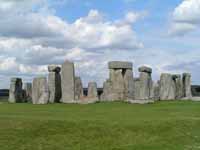Workers' village unearthed near Stonehenge circle
Archaeologists have uncovered what may have been a village for workers or festival-goers near the mysterious stone circle Stonehenge in England.

The village was located at Durrington Walls, about two miles (3.2 kilometers) from Stonehenge, and is also the location of a wooden version of the stone circle.
Eight houses have been excavated and the researchers believe there were at least 25 of them, archaeologist Mike Parker Pearson said Tuesday at a briefing held by the National Geographic Society.
The village was carbon dated to about 2600 B.C., about the same time Stonehenge was built. The Great Pyramid in Egypt was built at about the same time, said Parker Pearson of Sheffield University.
The small wooden houses had a central hearth, he said, and are almost identical to stone houses built at about the same time in the Orkney Islands.
The researchers speculated that Durrington Walls was a place for the living and Stonehenge where several cremated remains have been found was a cemetery and memorial. Both are connected to the Avon River by paths they called avenues.
Parker Pearson said remains of stone tools, animal bones, arrowheads and other artifacts were uncovered in the village, reports AP.
Remains of pigs indicated they were about nine months old when killed, which would mark a midwinter festival, he said.
Parker Pearson said Stonehenge was oriented to face the midsummer sunrise and midwinter sunset, while the wooden circle at Durrington Walls faced the midwinter sunrise and midsummer sunset.
Subscribe to Pravda.Ru Telegram channel, Facebook, RSS!




